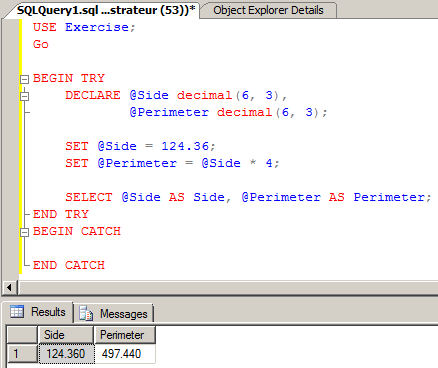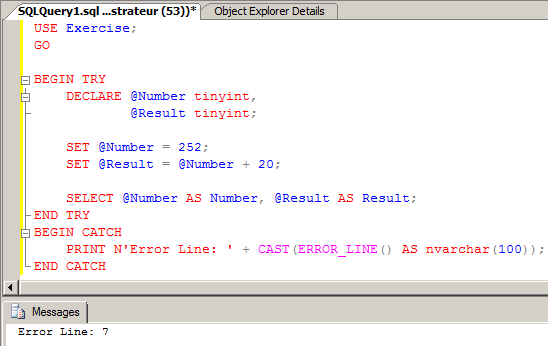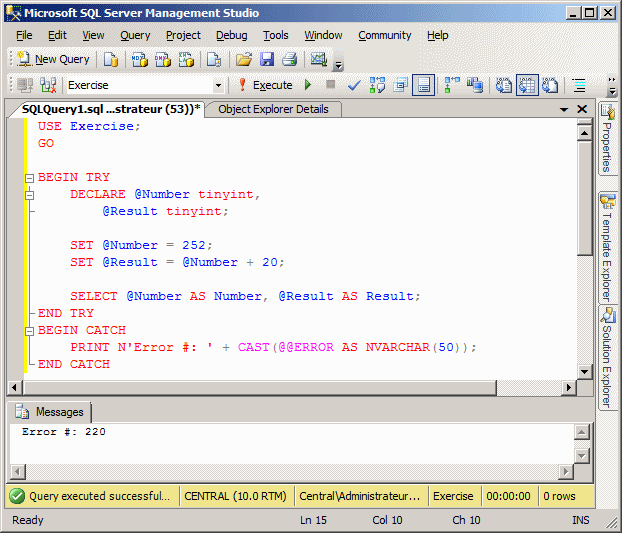|
|
Some problems will happen during the lifetime of a
database application. You cannot eliminate this fact. Instead, you can
anticipate as many problems as possible and take appropriate actions.
Normally, Microsoft SQL Server provides some means of taking care of
problems.
|
In reality, when it comes to a Microsoft SQL Server
database application, you can take care of problems on either the
Microsoft SQL Server side or on a programming environment you are using to
create a graphical application.
|
 Practical
Learning: Introducing Exception Handling Practical
Learning: Introducing Exception Handling
|
|
- Start the computer and log in
- Start Microsoft SQL Server
- In the Authentication combo box, make sure Windows Authentication
is selected and click Connect
- On the Standard toolbar, click the New Query button

- To create a new database, type the following
CREATE DATABASE Exercise2
ON PRIMARY
( NAME = DataRepository, FILENAME = 'C:\Microsoft SQL Server Database Development\Exercise2.mdf')
LOG ON
( NAME = DataLog, FILENAME = 'C:\Microsoft SQL Server Database Development\Exercise2.ldf');
GO
- Press F5 to execute
|
Types of Errors: Syntax Errors
|
|
There are various categories of errors you can deal
with. A syntax error occurs if you try writing code that Transact-SQL does
not allow. Examples are:
- If you try typing an operator or a keyword where it should not be,
the Code Editor would show it to you. Here is an example:

This error is because the SET operator,
although part of the Transact-SQL, was used wrongly.
- If you wrongly type a keyword or an operator probably because you
don't remember it, the Code Editor would signal it. Here is an
example:

- If you forget to type something necessary or required, when you
try executing the code, it would produce an error
Syntax errors are usually easy to detect because the
Code Editor points them out right away. Consequently, these errors are
easy to fix.
If you use a command-based application such as SQLCMD
or PowerShell, it would not show the error right way. It would show it
when you execute the code.
|
Types of Errors: Run-Time Errors
|
|
A run-time error is the type that occurs if your
application tries to perform an operation that either or both Microsoft
SQL Server and/or the operating system do not allow. These errors can be
difficult to fix because sometimes they are not clear, or what happens as
the error is not clearly identified or is external to the database. The
problem could be that, when testing the database in Microsoft SQL Server,
it may work just fine, but after the application has been distributed and
is used, problems start occurring.
Examples of run-time errors are:
- Trying to execute code that is not available or is not clearly
defined
- Performing a bad calculation such as a division by 0

Notice that the Code Editor does not signal any problem, because
this is not a syntax error
- Trying to use a function, a stored procedure, or a trigger that is
not available
- Using or accessing computer memory that is not available or enough
- Trying to perform an operation that either a variable or an object
cannot handle. An example is trying to store in a variable a value
that is beyond its allowable range. Here is an example:

Notice that the Code Editor does not signal any problem, because
this is not a syntax error
- Performing an operation on incompatible types
- Wrongly using a conditional statement, or using a mis-constructed
conditional statement
Run-time errors can be difficult to locate and fix.
Exception handling is the ability to deal with errors
that occur or can occur on a database. The error is called an exception.
To assist you with handling exceptions, Transact-SQL provides a general
formula. You start with a section as follows:
 |
BEGIN TRY
Normal code
END TRY
Between the BEGIN TRY and the END
TRY lines, write the normal code you want to execute. Here is
an example.
BEGIN TRY
DECLARE @Side decimal(6, 3),
@Perimeter decimal(6, 3);
SET @Side = 124.36;
SET @Perimeter = @Side * 4;
SELECT @Side AS Side, @Perimeter AS Perimeter;
END TRY
The section of code that starts from BEGIN
TRY to END TRY is called a try block or a try clause.
|
After the try block, you must create another section
that starts with BEGIN CATCH and ends with END CATCH:
BEGIN TRY
Normal code
END TRY
BEGIN CATCH
END CATCH
The section of code that goes from BEGIN CATCH
to END CATCH is called a catch block or a catch clause.
Among the rules you must observe:
- If you create a try block, you must also create a catch block
- There must not be any Transact-SQL code (except a comment, that is
not SQL code anyway) between the END TRY and the BEGIN CATCH
lines
If no error happens in the try block, you can leave
the catch block empty. Here is an example:
USE Exercise;
Go
BEGIN TRY
DECLARE @Side decimal(6, 3),
@Perimeter decimal(6, 3);
SET @Side = 124.36;
SET @Perimeter = @Side * 4;
SELECT @Side AS Side, @Perimeter AS Perimeter;
END TRY
BEGIN CATCH
END CATCH
This would produce:

Imagine you write code that could produce an error:
USE Exercise;
GO
DECLARE @Number tinyint,
@Result tinyint;
SET @Number = 252;
SET @Result = @Number + 20;
SELECT @Number AS Number, @Result AS Result;
GO
This would produce:

To address this type of problem, you can use exception
handling and include the normal code in a try block. Then, if an error
occurs in the try block, you can use the catch block to display a message.
Here is an example:
USE Exercise;
GO
BEGIN TRY
DECLARE @Number tinyint,
@Result tinyint;
SET @Number = 252;
SET @Result = @Number + 20;
SELECT @Number AS Number, @Result AS Result;
END TRY
BEGIN CATCH
PRINT N'There was a problem with the program';
END CATCH
On the other hand, if no error occurs in the try
block, that try block executes but when it ends, the execution skips the
catch block and continues execution with code below the END CATCH
line, if any.
|
 Practical
Learning: Creating an Exception Practical
Learning: Creating an Exception
|
|
- Select the whole text in the editor and type the following:
USE Exercise;
GO
BEGIN TRY
DECLARE @Number tinyint,
@Result tinyint;
SET @Number = 252;
SET @Result = @Number + 20;
SELECT @Number AS Number, @Result AS Result;
END TRY
BEGIN CATCH
PRINT N'There was a problem with the program';
END CATCH
GO
-
Press F5 to execute.
This would produce:

To assist you with identifying an error that has
occurred, Transact-SQL provides various functions.
When an error occurs in your code, probably the first
thing you want to know is where the error occurred in your code. To assist
you with this, Transact-SQL provides a function named ERROR_LINE.
Its syntax is:
int ERROR_LINE();
This function doesn't take an argument. It returns a
number that represents the line number where the error occurred.
Using a conditional statement, you can question the
database engine to know the line where the error occurred. With this
information, you can take the necessary action.
|
 Practical
Learning: Getting an Error Line Number Practical
Learning: Getting an Error Line Number
|
|
- Change the code in the text editor as follows:
USE Exercise;
GO
BEGIN TRY
DECLARE @Number tinyint,
@Result tinyint;
SET @Number = 252;
SET @Result = @Number + 20;
SELECT @Number AS Number, @Result AS Result;
END TRY
BEGIN CATCH
PRINT N'Error Line: ' + CAST(ERROR_LINE() AS nvarchar(100));
END CATCH
GO
-
Press F5 to execute.
This would produce:

Every type of error is recognized with a specific
number, which is just a type of identity (we will see how you can use that
number; but, as a numeric value, that number doesn't indicate anything).
To know the number of an error, you can call the ERROR_NUMBER()
function. Its syntax is:
int ERROR_NUMBER();
This function takes no argument and returns an
integer. Here is an example of calling it:
USE Exercise;
GO
BEGIN TRY
DECLARE @Number tinyint,
@Result tinyint;
SET @Number = 252;
SET @Result = @Number + 20;
SELECT @Number AS Number, @Result AS Result;
END TRY
BEGIN CATCH
ERROR_NUMBER();
END CATCH
You can then get the error number to take action. Here
is an example of finding out the number:

To find out what error number was produced by your
code, you can inquire about the value produced by the ERROR_NUMBER()
function. To do that, you can write an IF conditional statement.
If/once you know the error number, you can take an
appropriate action. At the least you can display a message. Here is an
example:

Of course, you can take better action than that.
In previous versions of Microsoft SQL Server, the
means of getting an error number was to call a function named @@ERROR.
You can still use this function to find out what the error number is in
order to take an appropriate action. Its syntax is:
int @@ERROR();
This function can be called to get the error number
produced by an exception. Here is an example;
USE Exercise;
GO
BEGIN TRY
DECLARE @Number tinyint,
@Result tinyint;
SET @Number = 252;
SET @Result = @Number + 20;
SELECT @Number AS Number, @Result AS Result;
END TRY
BEGIN CATCH
PRINT N'Error #: ' + CAST(@@ERROR AS NVARCHAR(50));
END CATCH
This would produce:

Just as done for the ERROR_NUMBER() function,
you can check the value of the @@ERROR call to find out what the
error number is, and if it is the right number you are looking for, you
can take appropriate action.
|
 Practical
Learning: Checking an Error Number Practical
Learning: Checking an Error Number
|
|
- Change the code in the text editor as follows:
USE Exercise;
GO
BEGIN TRY
DECLARE @Number tinyint,
@Result tinyint;
SET @Number = 252;
SET @Result = @Number + 20;
SELECT @Number AS Number, @Result AS Result;
END TRY
BEGIN CATCH
IF @@ERROR = 220
PRINT N'Something went wrong with your code';
END CATCH
GO
-
Press F5 to execute
An error number is just a number built in the function
code and known by the database engine. That number does not give any
meaningful indication about the error. To give you a message related to
the error, Transact-SQL provides the ERROR_MESSAGE() function. Its
syntax is:
nvarchar ERROR_MESSAGE();
This function takes no argument and it returns a
string. Here is an example of calling it:
USE Exercise;
GO
BEGIN TRY
DECLARE @Number tinyint,
@Result tinyint;
SET @Number = 252;
SET @Result = @Number + 20;
SELECT @Number AS Number, @Result AS Result;
END TRY
BEGIN CATCH
PRINT ERROR_MESSAGE();
END CATCH
This would produce:

Because you are a programmer, you should understand
the meaning of the words overflow, error, and tinyint.
Unfortunately, this message may not be very clear to a regular user. For
this reason, you should provide an easy way to read the message. You can
even combine your own error message to the value of the ERROR_MESSAGE()
function.